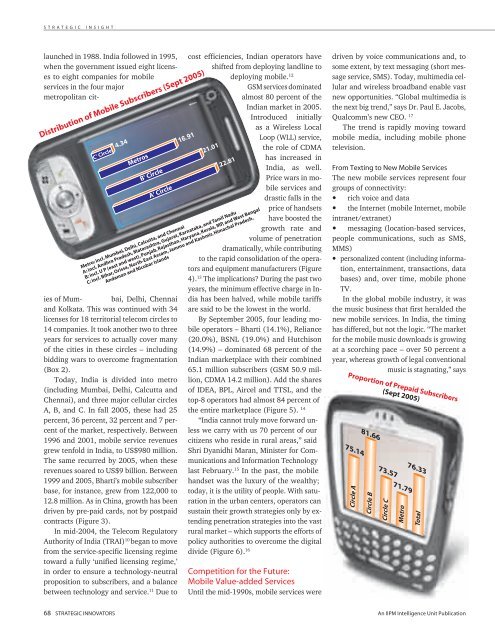Strategic Thought Transformation - The IIPM Think Tank
Strategic Thought Transformation - The IIPM Think Tank
Strategic Thought Transformation - The IIPM Think Tank
Create successful ePaper yourself
Turn your PDF publications into a flip-book with our unique Google optimized e-Paper software.
S T R A T E G I C I N S I G H T<br />
launched in 1988. India followed in 1995,<br />
when the government issued eight licenses<br />
to eight companies for mobile<br />
services in the four major<br />
metropolitan cities<br />
of Mum- bai, Delhi, Chennai<br />
and Kolkata. This was continued with 34<br />
licenses for 18 territorial telecom circles to<br />
14 companies. It took another two to three<br />
years for services to actually cover many<br />
of the cities in these circles – including<br />
bidding wars to overcome fragmentation<br />
(Box 2).<br />
Today, India is divided into metro<br />
(including Mumbai, Delhi, Calcutta and<br />
Chennai), and three major cellular circles<br />
A, B, and C. In fall 2005, these had 25<br />
percent, 36 percent, 32 percent and 7 percent<br />
of the market, respectively. Between<br />
1996 and 2001, mobile service revenues<br />
grew tenfold in India, to US$980 million.<br />
<strong>The</strong> same recurred by 2005, when these<br />
revenues soared to US$9 billion. Between<br />
1999 and 2005, Bharti’s mobile subscriber<br />
base, for instance, grew from 122,000 to<br />
12.8 million. As in China, growth has been<br />
driven by pre-paid cards, not by postpaid<br />
contracts (Figure 3).<br />
In mid-2004, the Telecom Regulatory<br />
Authority of India (TRAI) 10 began to move<br />
from the service-specific licensing regime<br />
toward a fully ‘unified licensing regime,’<br />
in order to ensure a technology-neutral<br />
proposition to subscribers, and a balance<br />
between technology and service. 11 Due to<br />
cost efficiencies, Indian operators have<br />
shifted from deploying landline to<br />
deploying mobile. 12<br />
GSM services dominated<br />
almost 80 percent of the<br />
Indian market in 2005.<br />
Introduced initially<br />
as a Wireless Local<br />
Loop (WLL) service,<br />
the role of CDMA<br />
has increased in<br />
India, as well.<br />
Price wars in mobile<br />
services and<br />
drastic falls in the<br />
price of handsets<br />
have boosted the<br />
growth rate and<br />
volume of penetration<br />
dramatically, while contributing<br />
to the rapid consolidation of the operators<br />
and equipment manufacturers (Figure<br />
4). 13 <strong>The</strong> implications During the past two<br />
years, the minimum effective charge in India<br />
has been halved, while mobile tariffs<br />
are said to be the lowest in the world.<br />
By September 2005, four leading mobile<br />
operators – Bharti (14.1%), Reliance<br />
(20.0%), BSNL (19.0%) and Hutchison<br />
(14.9%) – dominated 68 percent of the<br />
Indian marketplace with their combined<br />
65.1 million subscribers (GSM 50.9 million,<br />
CDMA 14.2 million). Add the shares<br />
of IDEA, BPL, Aircel and TTSL, and the<br />
top-8 operators had almost 84 percent of<br />
the entire marketplace (Figure 5). 14<br />
“India cannot truly move forward unless<br />
we carry with us 70 percent of our<br />
citizens who reside in rural areas,” said<br />
Shri Dyanidhi Maran, Minister for Communications<br />
and Information Technology<br />
last February. 15 In the past, the mobile<br />
handset was the luxury of the wealthy;<br />
today, it is the utility of people. With saturation<br />
in the urban centers, operators can<br />
sustain their growth strategies only by extending<br />
penetration strategies into the vast<br />
rural market – which supports the efforts of<br />
policy authorities to overcome the digital<br />
divide (Figure 6). 16<br />
Competition for the Future:<br />
Mobile Value-added Services<br />
Until the mid-1990s, mobile services were<br />
driven by voice communications and, to<br />
some extent, by text messaging (short message<br />
service, SMS). Today, multimedia cellular<br />
and wireless broadband enable vast<br />
new opportunities. “Global multimedia is<br />
the next big trend,” says Dr. Paul E. Jacobs,<br />
Qualcomm’s new CEO. 17<br />
<strong>The</strong> trend is rapidly moving toward<br />
mobile media, including mobile phone<br />
television.<br />
From Texting to New Mobile Services<br />
<strong>The</strong> new mobile services represent four<br />
groups of connectivity:<br />
rich voice and data<br />
the Internet (mobile Internet, mobile<br />
intranet/extranet)<br />
messaging (location-based services,<br />
people communications, such as SMS,<br />
MMS)<br />
personalized content (including information,<br />
entertainment, transactions, data<br />
bases) and, over time, mobile phone<br />
TV.<br />
In the global mobile industry, it was<br />
the music business that first heralded the<br />
new mobile services. In India, the timing<br />
has differed, but not the logic. “<strong>The</strong> market<br />
for the mobile music downloads is growing<br />
at a scorching pace – over 50 percent a<br />
year, whereas growth of legal conventional<br />
music is stagnating,” says<br />
68<br />
STRATEGIC INNOVATORS<br />
An <strong>IIPM</strong> Intelligence Unit Publication





![[Feb 2008, Volume V Annual Issue] Pdf File size - The IIPM Think Tank](https://img.yumpu.com/43961117/1/190x245/feb-2008-volume-v-annual-issue-pdf-file-size-the-iipm-think-tank.jpg?quality=85)
![[June 2008, Volume V Quarterly Issue] Pdf File size - The IIPM Think ...](https://img.yumpu.com/41693247/1/190x245/june-2008-volume-v-quarterly-issue-pdf-file-size-the-iipm-think-.jpg?quality=85)







![[Dec 2007, Volume 4 Quarterly Issue] Pdf File size - The IIPM Think ...](https://img.yumpu.com/29766298/1/190x245/dec-2007-volume-4-quarterly-issue-pdf-file-size-the-iipm-think-.jpg?quality=85)

![[Volume VI | Quarterly Issue: 31st May 2009] Pdf File size](https://img.yumpu.com/27796051/1/190x245/volume-vi-quarterly-issue-31st-may-2009-pdf-file-size.jpg?quality=85)